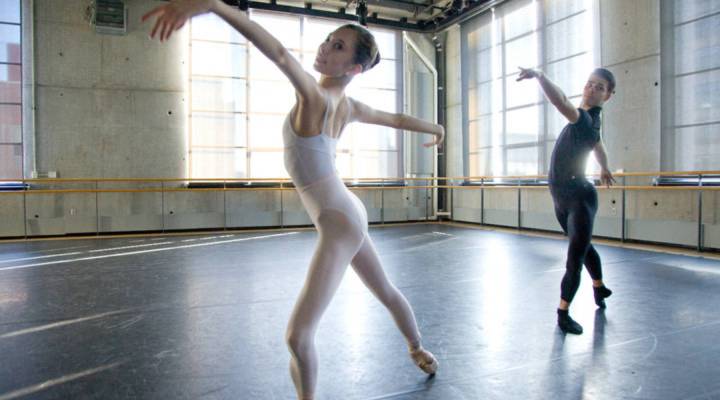
In ballet, dreams are expensive
Share Now on:
In ballet, dreams are expensive

Stacey Vanek Smith: The documentary “First Position” opens this weekend. The film focuses on several young dancers competing in an international competition, the Youth America Grand Prix. But mostly, the film is about what it takes to be a professional dancer. Turns out, it takes a lot of hard work and a lot of money. At the Manhattan Movement and Arts Center I caught up with Miko Fogarty, one of the dancers featured in the film. In a black leotard and tights, she showed me her first position.
Miko Fogarty: This is first position. It’s where you’re turned out and standing with your knees together.
The film’s director, Bess Kargman, grew up dancing ballet and made the movie because she wanted to understand what it took to go pros. But when she started making the film, she was schocked at how expensive it was.
Bess Kargman: Pointe shoes cost $80, some kids go through a pair a day. Tutus; the average price of a tutu is about $2,000. Miko’s needed at least six this year.
And that’s just the clothing. Miko’s mother, Satoko Fogarty, says the real expense is the thousands they pay in competition entry fees and, of course, ballet school.
Satoko Fogarty: $35,000 for tuition which includes class and private lesson. $35,000 a year. That’s at least, it might be more.
Mrs. Fogarty estimates it all adds up to nearly $50,000 a year. For families that can’t afford that stiff price tag, there are options. Director Bess Kargman says that’s why she chose to profile one dancer from Colombia whose family is not wealthy.
Kargman: While you don’t necessarily have to be rich to make it as a dancer, you have to figure out a way to pay these costs. That’s why scholarships for young dancer dancers are so important.
And family support. Getting serious about ballet means lots of time on the road, picking up and dropping off and even moving.
Kargman: A lot, a lot, a lot of times dancers, their whole families move to be closer to ballet school, just as is the case with Miko. And fequently, parents have to take second and third jobs.
Miko’s family moved to be closer to her ballet school; her father paid to relocate his office. Even at 14, Miko is very aware of the sacrifices her family is making.
Miko Fogarty: It’s kind of weird thinking your family just spends so much money. Yeah, it’s kind of weird hearing everything, but it’s reality.
Another reality? Even for dancers who do make it, salaries aren’t high. Companies pay starting dancers about $60,0000 a year — and salaries doesn’t go up much from there. But Satoko Fogarty says supporting her daughter is about more than money.
Satoko Fogarty: I don’t know if I should say this or not, but I think Miko is born to be a ballerina. We are there to make her dream come.
The Grand Prix competition gives out scholarship positions at ballet programs all over the world. This year, Miko placed 12th and got a scholarship at the Princess Grace school for ballet in Monaco.
Miko Fogarty: It’s such a huge deal because it’s a scholarship, you don’t have to pay for all the classes. It’s in France, right?
In New York, I’m Stacey Vanek Smith for Marketplace.
There’s a lot happening in the world. Through it all, Marketplace is here for you.
You rely on Marketplace to break down the world’s events and tell you how it affects you in a fact-based, approachable way. We rely on your financial support to keep making that possible.
Your donation today powers the independent journalism that you rely on. For just $5/month, you can help sustain Marketplace so we can keep reporting on the things that matter to you.












